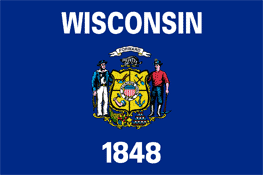Wisconsin State Standards for Language Arts: Grade 4

Currently Perma-Bound only has suggested titles for grades K-8 in the Science and Social Studies areas. We are working on expanding this.
WI.A. Reading/Literature: Students in Wisconsin will read and respond to a wide range of writing to build an understanding of written materials, of themselves, and of others.
A.4.1. Use effective reading strategies to achieve their purposes in reading.
4.1.1. Use a variety of strategies and word recognition skills, including rereading, finding context clues, applying their knowledge of letter-sound relationships, and analyzing word structures.
4.1.2. Infer the meaning of unfamiliar words in the context of a passage by examining known words, phrases and structures.
4.1.3. Demonstrate phonemic awareness by using letter/sound relationships as aids to pronouncing and understanding unfamiliar words and text.
4.1.4. Comprehend reading by using strategies such as activating prior knowledge, establishing purpose, self-correcting and self-monitoring, rereading, making predictions, finding context clues, developing visual images, applying knowledge of text structures, and adjusting reading rate according to purpose and difficulty.
4.1.5. Read aloud with age-appropriate fluency, accuracy, and expression.
4.1.6. Discern how written texts and accompanying illustrations connect to convey meaning.
4.1.7. Identify and use organizational features of texts, such as headings, paragraphs, and format, to improve understanding.
4.1.8. Identify a purpose for reading, such as gaining information, learning about a viewpoint, and appreciating literature.
A.4.2. Read, interpret, and critically analyze literature.
4.2.1. Recognize and recall elements and details of story structure, such as sequence of events, character, plot, and setting, in order to reflect on meaning.
4.2.3. Draw upon a reservoir of reading materials, including fairy tales, fables, and narratives from the United States and cultures worldwide, to understand plots, make predictions, and relate reading to prior knowledge and experience.
4.2.4. Summarize ideas drawn from stories, identifying cause-and-effect relationships, interpreting events and ideas, and connecting different works to each other and to real-life experiences.
4.2.5. Extend the literal meaning of a text by making inferences, and evaluate the significance and validity of texts in light of prior knowledge and experience.
A.4.3. Read and discuss literary and nonliterary texts in order to understand human experience.
4.3.1. Demonstrate the ability to integrate general knowledge about the world and familiarity with literary and nonliterary texts when reflecting upon life's experiences.
4.3.2. Identify and summarize main ideas and key points from literature, informational texts, and other print and nonprint sources.
4.3.3. Distinguish fiction from nonfiction, realistic fiction from fantasy, biography from autobiography, and poetry from prose.
4.3.4. Select a variety of materials to read for discovery, appreciation, and enjoyment, summarize the readings, and connect them to prior knowledge and experience.
A.4.4. Read to acquire information.
4.4.1. Summarize key details of informational texts, connecting new information to prior knowledge.
4.4.2. Identify a topic of interest then seek information by investigating available text resources.
WI.B. Writing: Students in Wisconsin will write clearly and effectively to share information and knowledge, to influence and persuade, to create and entertain.
B.4.1. Create or produce writing to communicate with different audiences for a variety of purposes.
B.4.2. Plan, revise, edit, and publish clear and effective writing.
4.2.2. Explain the extent and reasons for revision in conference with a teacher.
B.4.3. Understand the function of various forms, structures, and punctuation marks of standard American English and use them appropriately in communications.
4.3.5. Use punctuation marks and conjunctions, as appropriate, to separate sentences and connect independent clauses.
4.3.6. Use commas correctly to punctuate appositives and lists.
4.3.7. Spell frequently used words correctly.
4.3.8. Use word order and punctuation marks to distinguish statements, questions, exclamations, and commands.
WI.C. Oral Language: Students in Wisconsin will listen to understand and will speak clearly and effectively for diverse purposes.
C.4.1. Orally communicate information, opinions, and ideas effectively to different audiences for a variety of purposes.
C.4.2. Listen to and comprehend oral communications.
4.2.6. Distinguish fact from fantasy and fact from opinion.
4.2.7. Understand increasingly complex sentence structures.
4.2.8. Understand a variety of word structures and forms, such as affixes, roots, homonyms, antonyms, synonyms, and word analogies.
C.4.3. Participate effectively in discussion.
WI.D. Language: Students in Wisconsin will apply their knowledge of the nature, grammar, and variations of American English.
D.4.1. Develop their vocabulary of words, phrases, and idioms as a means of improving communication.
D.4.2. Recognize and interpret various uses and adaptations of language in social, cultural, regional, and professional situations, and learn to be flexible and responsive in their use of English.
WI.E. Media and Technology: Students in Wisconsin will use media and technology critically and creatively to obtain, organize, prepare and share information; to influence and persuade; and to entertain and be entertained.
E.4.1. Use computers to acquire, organize, analyze, and communicate information.
E.4.2. Make informed judgments about media and products.
E.4.3. Create products appropriate to audience and purpose.
E.4.4. Demonstrate a working knowledge of media production and distribution.
4.4.3. Identify sales approaches and techniques aimed at children.
E.4.5. Analyze and edit media work as appropriate to audience and purpose.
4.5.1. Generate and edit media work as appropriate to audience and purpose, sequencing the presentation effectively and adding or deleting information as necessary to achieve desired effects.
4.5.2. Provide feedback to (and receive it from) peers about the content, organization, and overall effect of media work.
WI.F. Research and Inquiry: Students in Wisconsin will locate, use, and communicate information from a variety of print and nonprint materials.
F.4.1. Conduct research and inquiry on self-selected or assigned topics, issues, or problems and use an appropriate form to communicate their findings.